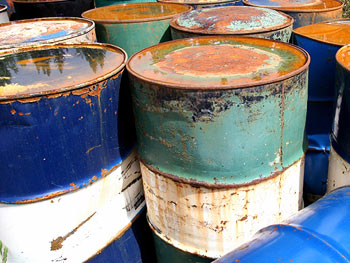
Chemical and toxic exposure can disrupt and endanger the lives of individuals who are exposed to hazardous materials in their work environment, homes or public places. When a legal action is brought on behalf of people injured by a harmful substance, it is known as a toxic tort. A tort is a civil wrongdoing that caused harm, and toxic means the harm was created by a toxic substance. Toxic torts cover a wide range of injuries, from silica dust exposure at work to lead paint poisoning in older homes.
Who Can Be Held Liable?
Toxic tort liability can be established for individuals and companies whose negligence has led to creating the unsafe toxic conditions. An individual lawsuit—or a class action filed by a group of injured people—may bring a settlement or a favorable verdict which will provide compensation for injury and damages suffered by the toxic tort victims, allowing them to regain their health and financial stability. Examples of those who can be held liable for injuries caused by hazardous substances include:
- Manufacturers of hazardous substances
- Distributors of hazardous substances
- Transporters of hazardous substances
- Those who store hazardous substances
- Those who own the property on which hazardous substances are created or stored
- Employers who exposed their workers to hazardous substances
- Manufacturers of equipment that exposed workers to hazardous substances
- Manufacturers of equipment that failed to keep workers protected from hazardous substances.
Negligent actions by any of these entities can lead to permanent, even life-threatening, injuries and illnesses that can be legally actionable.
Bodily Harm Caused by Exposure to Toxins
Any number of illnesses and chronic conditions can be caused by exposure to hazardous substances. Some of the illnesses linked to exposure to toxins are:
- Organ damage (liver, brain, kidneys)
- Many types of lung diseases, including silicosis, mesothelioma, “popcorn lung,” and berylliosis
- Nerve damage
- Cancers, including lymphomas
- Birth defects
- Reproductive problems
- Loss of motor skills.
Types of Toxic Tort Claims
Toxic torts can arise from exposure that occurs in several locations, such as:
- At work. This can be a high-level, short-term exposure, or steady exposure at lower levels over the years. Examples of the latter include asbestos and benzene exposures.
- In the home. Substances in your home that can put you at risk include mold and lead paint.
- From consumer products. Common household chemicals such as pesticides and herbicides can do damage.
Harmful Toxins in the Workplace
A wide variety of substances are harmful to human health, and they’re found in many places. Some dangerous chemicals are most likely to be used in industrial settings, exposing workers to unacceptable hazards. Maritime workers, miners, construction and demolition tradesmen, factory workers, plumbers and others in related jobs may be exposed to dangerous substances such as the following:
- Crystalline silica, beryllium, and lead dust can all create severe, occupational lung disease. Extremely fine, dust-like particles can lodge in a person’s lungs and, years later, cause various types of lung disease, such as silicosis and cancer.
- While asbestos has not been in the workplace officially for decades, anyone who works around old buildings or in shipyards is at risk from exposure to asbestos that was put in place before the Seventies, especially if they are tearing apart or cleaning up structures.
- Benzene. A petrochemical, benzene is widely used in a number of chemical processes. It is necessary to create polymers and a number of plastics, such as polystyrene and EPS. It has been linked to bone marrow disorders, including leukemias and lymphomas.
- Pesticides and herbicides. Perhaps the best example is Monsanto’s Roundup, which contains glyphosate and has been linked to liver damage and to non-Hodgkin’s lymphoma.
- Solvents in general. Industrial solvents are varied and widespread, and you can be dangerously exposed by breathing them, getting them on your skin, and swallowing them. Solvents are used to degrease and clean items, to create pesticides, and to create chemicals. Just a few common solvents in use are glycol esters, ketones, acetone, gasoline, hexane, methanol, toluene, turpentine, ethylene dichloride, trichloroethylene (TCE) and methylene chloride.
- Heavy metals. Many heavy metals are used in manufacturing; their dusts can cause injury to your lungs. Exposure to heavy metals can also poison you. Examples of heavy metals are mercury, lead, and arsenic.
- Chlorine and chlorinated solvents. Two of the most common ways to be exposed to chlorine are through the solvents trichloroethylene (TCE) and methylene chloride. Inhalation of these solvents can cause lung diseases and problems such as kidney cancer.
- Carbon monoxide and diesel exhaust exposure. Carbon monoxide (CO) can kill you if you inhale enough of it. Diesel exhaust (DE) contains particulates that, like industrial dusts, can lodge in the lungs, creating health problems. DE also is composed of a number of toxic compounds such as sulfur dioxide and nitrogen oxides.
- Formaldehyde and isocyanates. These substances are risky to inhale and occur in many settings, such as in the spray foam insulation Isocyanates, before they are “cured,” are toxic. Examples of isocyanates are methylene diphenyl diisocyanate (MDI) and toluene diisocyanate (TDI).
Toxins in the Home
It’s frightening for homeowners to find that their safe havens may also be harboring toxic substances that could cause serious illness. Whether the problem stemmed from the actions or inactions of a landlord, a contractor, an HVAC manufacturer or installer, or a nearby industrial activity, when a family’s home, water or air are poisoned, the responsible party should be held accountable in a court of law and the injured persons compensated. Some of the conditions that could be harmful in a residential setting are:
- If you have a dampness problem that goes unchecked, mold can be the result. Mold can create severe breathing problems; some people are even allergic to it. Mold requires proper remediation to ensure your safety. Two common forms of mold that can cause harm are “black mold” (Stachybotrys chartarum) and Aspergillis.
- Lead paint. Although lead has not been used in house paint for decades, older homes can still have it on walls and trim. It is especially dangerous to children and can cause permanent brain damage. For those in Baltimore, consulting a Baltimore brain injury attorney is crucial if you suspect lead paint exposure. Lead paint requires controlled, proper remediation to prevent harm, and legal guidance can ensure the right measures are taken.
- Fire retardants in furniture or carpeting. These items can give off fumes, or “off-gas,” for weeks or even months, causing a number of health problems and illnesses.
- If you live in an older home and you attempt any remodeling or repairs, you may run into asbestos. Asbestos was used for years because it is an excellent fire retardant. Asbestos, if not remediated properly, causes deadly disease.
- Contaminated water from fracking operations. Water that becomes dangerous to human health to drink or even use on your skin can be a danger resulting from nearby fracking operations.
- Release of hazardous materials from a truck/train collision or derailment. Crashes involving tractor-trailers carrying dangerous materials, as well as train accidents and derailments, can release hazardous materials into the air and the water supply.
While some toxic injuries are suffered by individuals of single residences, some can be felt by an entire community.

Filing Toxic Tort Legal Claims
One problem inherent in toxic tort cases is that the harm suffered is not always immediately apparent. While a chemical spill or explosion is likely to produce obvious and sudden injury, some toxic substances have long latency periods and their effects may not become evident for months or even years. State statutes of limitation, or deadlines, for filing personal injury claims related to toxic torts begin the moment the injury is discovered. This means that time is of the essence for those looking to bring manufacturers and negligent individuals to justice while obtaining the compensation they deserve.
Your Baltimore toxic tort attorney can help evaluate your claim, get in touch with expert witnesses, conduct a thorough investigation, and negotiate the discovery and court processes necessary to successful verdicts and settlements. Toxic tort cases are complex, touching on legal, medical and scientific issues. Steve Heisler’s multiple decades of experience have led to working relationships with the expert witnesses who will be critical to your case: physicians, epidemiologists, toxicologists, forensic economists, and environmental scientists.
At the Law Offices of Steven H. Heisler, we bring a high level of competence and concern to every case of personal injury we handle in Maryland. When citizens are harmed by corporations or others who allow the release of toxic substances into our air, water or homes, these same citizens know that Steve Heisler, The Injury Lawyer, will stand up for their rights to a healthful environment.
Let Down by the System? Let our Baltimore Toxic Tort Lawyers Help You
If you’re looking for a toxic torts attorney with experience, a successful track record and a reputation as an aggressive and competent advocate for personal injury victims in Baltimore and throughout the state of Maryland, look no further – the Law Offices of Steven H. Heisler focus on recovery for personal injury victims, including those who sustain injury from toxic materials. For a free and confidential evaluation of your case that involves an injury or illness with a suspected link to a dangerous substance, call us at 1-410-625-4878, or use our online contact form.

Attorney Steve Heisler
Steve Heisler decided in 1996 that he was going to focus his law practice exclusively on injury cases. Since then, he has been representing injured people against insurance companies, disreputable medical practitioners and Big Pharma, and doing it with compassion, honesty and level-headed rationality. [ Attorney Bio ]

